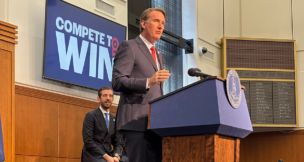Report: DOGE responsible for nearly 290k job cuts
Virginia feeling disproportionate sting from Trump federal layoffs
Josh Janney //August 1, 2025//

AdobeStock

AdobeStock
Report: DOGE responsible for nearly 290k job cuts
Virginia feeling disproportionate sting from Trump federal layoffs
Josh Janney //August 1, 2025//
SUMMARY:
- Trump administration‘s layoffs and spending cuts are driving a sharp rise in U.S. job losses
- Experts warn of economic ripple effects and a lack of matching jobs for displaced workers
- AI and automation are accelerating job cuts, especially in the tech sector.
A new report shows that federal layoffs initiated by the Trump administration’s Department of Government Efficiency remain the biggest culprit for job cut announcements so far this year, with experts saying the losses are disproportionately impacting Virginia.
In its July Challenger Report released Thursday, executive coaching firm Challenger, Gray & Christmas found that U.S.-based employers have announced 806,383 job cuts so far this year — more than all layoff announcements for 2024 and the highest year-to-date since 2020, when 1.84 million job cuts were announced.
This total is up 75% from the 460,530 job cuts announced through the first seven months of 2024 and is 6% higher than the 2024 full-year total of 761,358.
Employers announced 62,075 job cuts in July, up 29% from June’s 47,999 and up 140% from 25,885 announced in July 2024.
Government entities announced 3,666 job cuts in July, a slight decrease from 3,801 cuts announced in June.
DOGE: Leading U.S. job cuts
DOGE was cited in 289,679 planned layoffs so far this year, according to the report, and is the leading cause of job cuts thus far in 2025. That includes direct reductions to the federal workforce and its contractors. Furthermore, the report stated that an additional 13,056 cuts have been attributed to the downstream effects of federal layoffs and spending cuts, including loss of funding to private nonprofits and affiliated organizations. The report stated that market and economic conditions were the next most cited reason for workforce reductions, accounting for 171,083 cuts for the year to date.
Demographer Hamilton Lombard with the University of Virginia’s Weldon Cooper Center for Public Service said it’s difficult to assess how many of the federal layoffs are specific to Virginia. However, citing data from the 2023 Census Bureau’s American Community Survey, a Weldon Cooper Center study in April reported that Virginia had 321,516 federal employees going into 2025, more than nearly every other state, except for Maryland.
During a call with the media on Friday, U.S. Sen. Mark Warner said he’s held numerous recent town halls in Republican-led districts in Virginia where, he said, 70-80% of the people in attendance either had a family member or knew someone affected by federal layoffs.
“The fact is, the sloppiness of this operation and firing people, bringing them back, restarting — all that has cost,” Warner said. “If anybody had ever run a business before … that kind of uncertainty, that kind of jerking around, that kind of chaos, costs money.”
A “smart DOGE would have made sense,” said Warner, adding that if Democrats regain control of the federal government, he’s committed to rebuilding essential programs and services, albeit through a new model.
Terry L. Clower, Northern Virginia Chair and professor of public policy in the Schar School of Policy and Government at George Mason University, pointed to Bureau of Labor Statistics data that show Virginia lost 5,700 more federal jobs in June than in the same month last year.
Clower noted that the data does not yet reflect job losses that have been put on temporary hold due to legal challenges regarding whether the Trump administration can make broad-based job cuts. It’s also unclear, he said, how many people took voluntary buyouts offered by the Trump administration, which won’t be in effect until September.
The loss of federal jobs, Clower added, will also lead to a decline in regional household spending and indirect jobs that support federal workers. He said there are not enough jobs that match up in terms of occupations and skill sets to provide employment opportunities for all of the displaced federal workers, if the order of magnitude of the layoffs is what the administration said it would be.
Virginia needs to invest in other type of industries, particularly emerging industries and new opportunities, Clower said, in order to shore up the loss in economic activity that’s generated by the federal government in the Northern Virginia region.
Tariffs and AI
Meanwhile, retail announced 80,487 job cuts through July, representing a 249% increase from the 23,077 cuts announced during the same period last year. The Challenger Report cited tariffs, inflation, declines in consumer spending and economic uncertainty causing layoffs and store closures.
Nonprofits are also facing challenges from federal funding reductions and economic uncertainty, with these organizations announcing 17,826 job cuts so far in 2025, a 413% increase from the 3,477 announced through July last year.
Closings of stores, units, or plants have led to 120,226 layoffs so far this year, while restructuring efforts have resulted in 66,879 job cuts. Bankruptcies accounted for another 35,641 layoffs.
Technology led the private sector in nationwide job cuts, with 89,251 in 2025, a 36% increase from the 65,863 cuts tracked through July 2024. The tech industry is being reshaped by the advancement of artificial intelligence and ongoing uncertainty surrounding work visas, which have contributed to workforce reductions.
The report specifically said that technological updates, including the implementation of automation and AI, have resulted in 20,219 job cuts this year.
Speaking about AI’s impact on the economy and jobs, Warner said that while more businesses are adopting AI into their operations, which will increase productivity, “what I’m concerned about [is] … all those starter jobs that are … coming out of college, whether it’s in the government … or in the financial sector as an analyst, a lot of those jobs are never going to come back, because AI can do it quicker, faster, in a frankly more efficient way.”
F

















